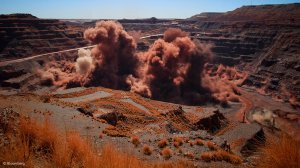Omnia H1 profit down 11% y/y amid drought, plant breakdown
South African chemicals producer Omnia on Tuesday reported that negative impacts on its agriculture division, including the drought and a breakdown at its Nitric Acid 2 complex, has seen its gross profit decrease by 11% year-on-year to R1.5-billion for the six months to September 30.
The Sasolburg-based Nitric Acid 2 plant was down for 86 days, resulting in lower throughput volumes and higher operating costs.
The group’s results were further impacted on by the mining division continuing to weather strong headwinds in the commodity sector and the chemicals division facing stagnant growth and pricing volatility.
Gross profit as a percentage of revenue decreased to 19.1%, compared with 22% in the prior corresponding period, owing to lower gross margins in the agriculture and mining divisions, offset marginally by the higher gross margin in the chemicals division.
However, Omnia recorded an increase in other operating income of 104.9% to R125-million, as a result of a portion of the insurance claim amounting to R57-million for the breakdown at the Nitric Acid 2 complex accounted for during the period under review, with the balance to be finalised before the financial year-end.
The chemicals division also concluded the sale of its Springs property for a profit of R5-million.
Operating profit decreased by 14.7% to R457-million owing to the reduction in the agriculture and mining divisions’ performance period-on-period. Overall, the operating margin for the six-month period reduced from 6.9% to 5.8%.
Net finance expenses increased by R17-million to R97-million as a result of the higher cost of hedging the US dollar equity position of R48-million and increased cost of borrowing owing to increases in the South African interest rates period-on-period.
Earnings before interest, taxes, depreciation and amortisation (Ebitda) was lower at R655-million, with the reduction attributable to the operating profit decreasing by R79-million and partially owing to depreciation and amortisation charges being higher at R198-million, with the commissioning of the Dryden emulsion plant in mid-2015 resulting in an increase in the charge period-on-period.
DIVISIONAL HIGHLIGHTS
The agriculture division’s revenue increased by 2.9% to R3.6-billion owing to higher volumes. “New business development in the Western Cape has been encouraging and farmers across South Africa are positive ahead of the planting season,” Omnia said in a statement on Tuesday.
Operating profit decreased by 35.8% to R102-million owing to lower margins, increased expenses as a result of the complex breakdown, higher year-end stock values and the additional losses in the agriculture trading segment.
The average ammonia-to-urea ratio remained at unfavourable levels of approximately 1.50 – higher than the long-term average for the past financial year.
In recent months, the ratio has fallen dramatically to less than 1.00 but will have minimal impact on the current year margins due to the lead time to purchase raw materials in advance of the production cycle. However, it will benefit the business in the following financial year.
The mining division’s revenue rose by 9.3% to R2.4-billion as volumes increased. The commodity cycle has begun to show signs of improvement resulting in additional contracts and volumes being secured. Following a series of technical upgrades, the improved performance of both the Megadet nonelectric detonators and the AXXIS electronic detonators has been positive, resulting in improved levels of customer service and satisfaction.
The installation of the new automated production facility for nonelectric detonators has raised the quality and performance of these units significantly and has enabled BME to secure further local and international sales volumes based on reliability and performance. The overall margin at 11.5% remains under pressure due to the competitive nature of the industry through the downturn of the commodity cycle.
The higher initial operating costs on a large-scale Zambia copper contract also impacted the operating profit in the first half and are expected to normalise going forward. Overall, the mining division’s operating profit decreased by 8.2% to R281-million with the outlook remaining positive.
Revenue in the chemicals division decreased by 5.8% to R1.8-billion on the back of lower volumes, partially offset by an increase in unit selling prices. The operating margin improved to 3.9% owing to competitive pricing achieved compared with the prior corresponding period with overheads decreasing slightly. Operating profits increased marginally to R74-million.
PROSPECTS
Despite the challenges, Omnia believes all divisions are well placed to deliver an improved performance in the second half of the financial year.
The agriculture division will move into the traditional summer planting season with the drought having receded, better rains forecast for the next few months and increased throughput and overhead recovery anticipated at the Sasolburg factory.
Speaking at a presentation of the company’s results, Omnia MD Rod Humphris said the company’s outlook for operating margin guidance for the 2017 financial year could be between 9% and 11% should the favourable ammonia-to-urea ratio continue, with the current low ammonia prices.
He pointed out that, even in unfavourable conditions, should the ammonia price spike in the next year, the company’s operating margin guidance would still be fairly high at between 7% and 9%.
Further, with Omnia’s R750-million nitro-phosphate plant progressing according to plan, the company will also see a boost in throughput and overhead recovery. Humphris said the plant was nearing completion, with stage one of civil works under way.
“This will bring some raw material production costs into our business,” he added.
Meanwhile, in the mining division, the operating margin outlook remained unchanged between 12% to 14%, but with Zambian copperbelt sales volumes expected to ramp up further, initial higher operating costs are set to normalise.
This will further be boosted by the company investing in automated production lines, with two additional lines being built by year-end.
Article Enquiry
Email Article
Save Article
Feedback
To advertise email advertising@creamermedia.co.za or click here
Comments
Announcements
What's On
Subscribe to improve your user experience...
Option 1 (equivalent of R125 a month):
Receive a weekly copy of Creamer Media's Engineering News & Mining Weekly magazine
(print copy for those in South Africa and e-magazine for those outside of South Africa)
Receive daily email newsletters
Access to full search results
Access archive of magazine back copies
Access to Projects in Progress
Access to ONE Research Report of your choice in PDF format
Option 2 (equivalent of R375 a month):
All benefits from Option 1
PLUS
Access to Creamer Media's Research Channel Africa for ALL Research Reports, in PDF format, on various industrial and mining sectors
including Electricity; Water; Energy Transition; Hydrogen; Roads, Rail and Ports; Coal; Gold; Platinum; Battery Metals; etc.
Already a subscriber?
Forgotten your password?
Receive weekly copy of Creamer Media's Engineering News & Mining Weekly magazine (print copy for those in South Africa and e-magazine for those outside of South Africa)
➕
Recieve daily email newsletters
➕
Access to full search results
➕
Access archive of magazine back copies
➕
Access to Projects in Progress
➕
Access to ONE Research Report of your choice in PDF format
RESEARCH CHANNEL AFRICA
R4500 (equivalent of R375 a month)
SUBSCRIBEAll benefits from Option 1
➕
Access to Creamer Media's Research Channel Africa for ALL Research Reports on various industrial and mining sectors, in PDF format, including on:
Electricity
➕
Water
➕
Energy Transition
➕
Hydrogen
➕
Roads, Rail and Ports
➕
Coal
➕
Gold
➕
Platinum
➕
Battery Metals
➕
etc.
Receive all benefits from Option 1 or Option 2 delivered to numerous people at your company
➕
Multiple User names and Passwords for simultaneous log-ins
➕
Intranet integration access to all in your organisation




















